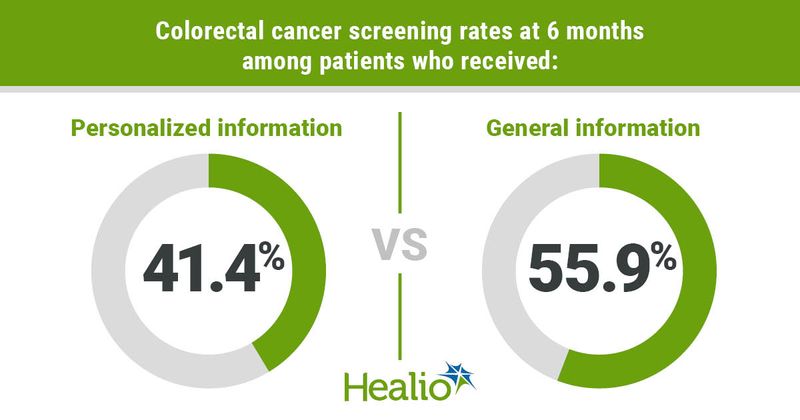Providing personalized details about CRC screening may better align orders with benefit
Key takeaways:
- Individuals given personalized information about CRC screening benefits and harms were more likely to receive screening orders that aligned with benefit.
- Data suggest this may reduce overall use of screening.
Older adults who were given personalized information about benefits and harms of colorectal cancer screening were more likely to receive screening orders that aligned with benefit, reducing overall use of screening, researchers reported.
“While guidelines have long recommended a more personalized approach to screening in average-risk individuals between ages 76 and 85 years, a personalized approach for patients aged 45 to 75 years has not been developed,” Sameer D. Saini, MD, MS, from the VA Ann Arbor Healthcare System and Michigan Medicine, and colleagues wrote in JAMA Internal Medicine. “This is particularly important for older patients in this cohort who may have significant comorbidities, but for whom guidelines and performance measures promote screening.”

They continued: “A more systematic, scalable and patient-centered approach is needed to guide older adults who may otherwise qualify for screening but have competing health issues that make the screening decision more complex.”
In an unmasked, randomized clinical trial, researchers evaluated the effect of personalized multilevel intervention on CRC screening orders among 431 older, average-risk adults (mean age, 71.5 years; 98.4% men) between November 2015 and February 2019 at two U.S. Department of Veterans Affairs facilities.
Those in the intervention group (n = 258) received detailed information on screening benefits and harms customized for each individual’s age, sex, screening history and comorbidities, while those in the control group (n = 173) received general screening information. Researchers noted 21.5% of participants were college-educated and 81.4% had undergone prior screening.
The primary outcome was whether CRC screening was ordered within 2 weeks of a primary care visit.
Results showed 62.8% of those in the intervention group and 65.9% of those in the control group received screening orders, a difference that was not statistically significant (adjusted difference = –4 percentage points; 95% CI, –15.4 to 7.4).
According to a prespecified interaction analysis, the proportion of participants who received screening orders was lower in the intervention group vs. the control group for those in the lowest benefit quartile (59.4% vs. 71.1%) and higher in the intervention group for those in the highest benefit quartile (67.6% vs. 52.2%).
At 6 months, 41.4% of the intervention group had undergone screening compared with 55.9% of the control group (adjusted difference = –13.4 percentage points; 95% CI, –25.3 to –1.6). Researchers noted the interaction effect between the study group and estimated benefit of screening was not significant.
“Older screen-due adults who were presented with detailed, personalized information about screening benefits and harms immediately before a primary care visit were more likely to receive screening orders concordant with benefit and were subsequently less likely to utilize screening overall than those who were not,” Saini and colleagues concluded. “The results are particularly notable considering that a minority of the study participants were college-educated and nearly one-third had limited health literacy.”
They continued: “A multilevel intervention that presents older adults with personalized information about screening benefits and harms, together with clinician education and system-level support, has the potential to align screening orders with screening benefit and decrease overall use of screening.”
